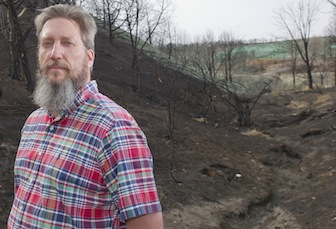Post wildfire recovery efforts could benefit greatly from Idaho State University/NASA/BLM GIS research project
November 8, 2012
Post-wildfire recovery efforts in Idaho – and then potentially nationwide – could receive a large boost from the results of a prototype GIS-based fire recovery "decision support system" being developed at Idaho State University.
In partnership with the Department of Interior's Bureau of Land Management, ISU and NASA scientists are building and evaluating a computerized decision support system that will be an automatically deployable, site-specific multi-criteria decision aid. It will bring together in a single application the information necessary, in the form of multi-layered GIS maps, for Burned Area Emergency Response (BAER) teams to plan reseeding strategies and monitor ecosystem recovery in the aftermath of wildfires.
 "We have all this cool GIS technology that works incredibly well," said Keith Weber, director of the ISU GIS Training and Research Project and principal investigator on the project. "In the big picture, we have the capability to put it to work to rapidly respond to an emergency situation."
"We have all this cool GIS technology that works incredibly well," said Keith Weber, director of the ISU GIS Training and Research Project and principal investigator on the project. "In the big picture, we have the capability to put it to work to rapidly respond to an emergency situation."
"If we can demonstrate that our system works well," continued Weber, "NASA would like this system to be available nationwide."
The researchers are compiling specific data sets, already available from a variety of sources, that are used in the construction of Geographic Information System (GIS) maps that land managers can use to assist them in creating post-fire recovery plans within hours after a fire has been declared contained.
"We are assembling a tremendous number of GIS datasets that show characteristics like elevation, slope and if a specific area is a wetland or is used for grazing," Weber said. "We're building up a library of data sets that will be used to create on-line GIS maps, similar in some ways to Google Earth, for use by land managers giving them comprehensive, site-specific information about each fire."
These baseline data sets are being collected for the entire state of Idaho. Beginning next wildfire season, however, researchers will begin testing the effectiveness of the system for wildfires specifically in Southeast Idaho.
The new RECOVER program will automatically generate and refresh derived fire severity, fire intensity and other information throughout the burn, producing easily understandable GIS maps. Thus, when a fire is contained, BAER teams will have at hand a complete and ready-to-use RECOVER system customized for the target wildfire.
"From my perspective as a GIS Specialist, utilizing the RECOVER decision support system will be a progressive step forward for the BLM in improved mapping and response to fire disturbances," said Brian Holmes, BLM Pocatello Field Office. “"The necessary data and processing capabilities will all be available in one place to increase efficiency, reduce cost and facilitate data sharing."
The BLM's policy is to have an initial Emergency Stabilization plan submitted within seven calendar days of the wildfire control date, and the complete Emergency Stabilization plan submitted within 21 calendar days to the appropriate state and/or Washington office for approval. The new RECOVER system has the potential to significantly improve the decision-making process in this tight timeframe, according to Weber.
The GIS maps created of fire areas will be based on new satellite imagery of the burned areas that will be taken from within a few days to a few hours after a fire is declared contained. Once they’ve received that imagery, it can be processed within a few hours. RECOVER will use state-of-the-art cloud-based data management technologies developed by NASA Goddard Space Flight Center to improve performance, reduce cost and provide site-specific flexibility for each fire. This technology is also being used in the NASA Center for Climate Simulation, which sets the stage for using climate data products in future versions of the RECOVER system.
"This tool will help fire managers immensely, especially on larger fires," Weber said. "On a 200,000- or 300,000-acre fire an individual fire manager may be familiar with some of the land, and have ground observation of some of the burn, but this new system will give comprehensive site information across the entire area burned."
Initial funding of $180,000 for this project is being provided by NASA's Applied Sciences Program and the NASA High-end Computing Program.
This project will be presented in detail at the GIS Day event at ISU on Wednesday, Nov. 14. Visit http://giscenter.isu.edu/gisday/index.htm for more information on GIS Day.
###
Categories:
